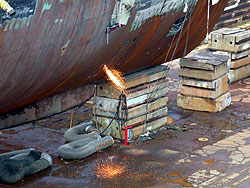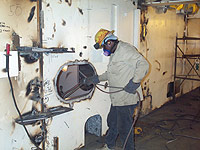Shipyard Employment eTool
Hot Work (including Welding, Cutting and Heating) >> Hot Work in Confined Spaces

Due to the unique hazards associated with hot work in confined spaces, additional controls are required. The following include specific requirements for hot work in confined spaces:
- Hot work operations in confined spaces
- Fall Hazards
- Ventilation requirements
- Fire prevention requirements
- PPE requirements
The module outlining the requirements for Hot Work in Enclosed Spaces must be reviewed for the basic requirements before reviewing the module regarding other locations, or these requirements for confined spaces.

Potential Hazards
Due to the isolation and difficulty of egress, hot work operations in confined spaces present additional hazards. These include:
- Impeded egress from the space under emergency conditions
- Undiscovered worker injury and delay of treatment.
Requirements and Example Solutions
- Provide, if possible, more than one means of access to the space. [29 CFR 1915.76(b)]
- Keep access to the space clear. [29 CFR 1915.51(c)]
- Employees working alone in a confined space must be checked on at regular intervals [29 CFR 1915.84(a)].

Fall hazards are a leading cause of shipyard fatalities. Shipyard employees are often required to work in dangerous environments that may include fall hazards. Accidents involving elevation equipment such as ladders, scaffolds, and aerial lifts are often serious, even fatal. Workers also risk falls from open deck edges.
Potential Hazards
Deck Openings and Edges
- Falls from deck openings
- Falls into open holes
Scaffolds
- Falls from ladders
- Falls from scaffolds
Requirements and Example Solutions
Personal Fall Protection
- If fall hazards are identified through the Hazard Assessment required in 29 CFR 1915.152(b), employees must be protected from falls by the use of personal fall protection equipment. [29 CFR 1915.152(a)];
- Guard rails may be used in lieu of personal fall protection, even though they are not required in shipbreaking. For guard rail specifications, see 29 CFR 1915.71(j).
Fall Protection for Scaffold Work
- Guardrails or other appropriate fall protection must be used when working on scaffolds 5 feet above surfaces. [29 CFR 1915.71(j)]
For more detailed information, review Personal Fall Protection Equipment.
- SHAC recommends that personal fall protection including lanyards and harnesses be used and secured during installation of guardrails and erection and dismantling of scaffolds.

Potential Hazard
Confined spaces usually do not have adequate natural ventilation, which may expose workers to hazardous fumes and gases.
Requirements and Example Solutions
- Use adequate mechanical ventilation or airline respirators for hot work in confined spaces. [29 CFR 1915.51(b)]
- Keep access clear of blockage from ventilation equipment. [29 CFR 1915.51(c)]
- If the ventilation equipment blocks access to the space, airline respirators as well as a stand-by employee must be available. [29 CFR 1915.51(c)(3)]
See Hot Work in Enclosed Spaces for the basic requirements regarding ventilation.

Potential Hazard
Because confined spaces have little or no natural ventilation, flammable gases may accumulate to hazardous levels, even when unoccupied, exposing workers to risk of fire or explosion upon re-entry.
Requirements and Example Solutions
Work in confined spaces requires certain restrictions regarding what equipment can be taken inside and what equipment can be left inside when unoccupied.
- Torches and hoses must be removed from confined spaces when the space is unoccupied such as during lunch breaks and shift changes. [29 CFR 1915.503(b)(2)]
- Oxygen and fuel gas cylinders must not be taken into confined spaces. [29 CFR 1915.55(b)(4)]
See Hot Work in Enclosed Spaces for the basic requirements regarding fire prevention.
Potential Hazard
Workers performing hot work in confined spaced during Shipbreaking operations are exposed to respiratory hazards such as metal fumes, gases and dust. Local exhaust or dilution ventilation is often not feasible to provide protection, therefore personal protective equipment (PPE) is warranted.
Requirements and Example Solutions
The following are specific requirements for PPE during hot work operations in confined spaces.
- Use airline respirators when access to the space is blocked. [29 CFR 1915.51(c)(3)]
- Use airline respirators when welding on beryllium-containing base or filler metals. [29 CFR 1915.51(d)(2)(iv)]
- Use PPE in accordance with requirement for hot work in enclosed spaces if not superseded by the above requirements. [29 CFR 1915.51(d)]
For more specific information, see PPE Selection: Hot Work.

